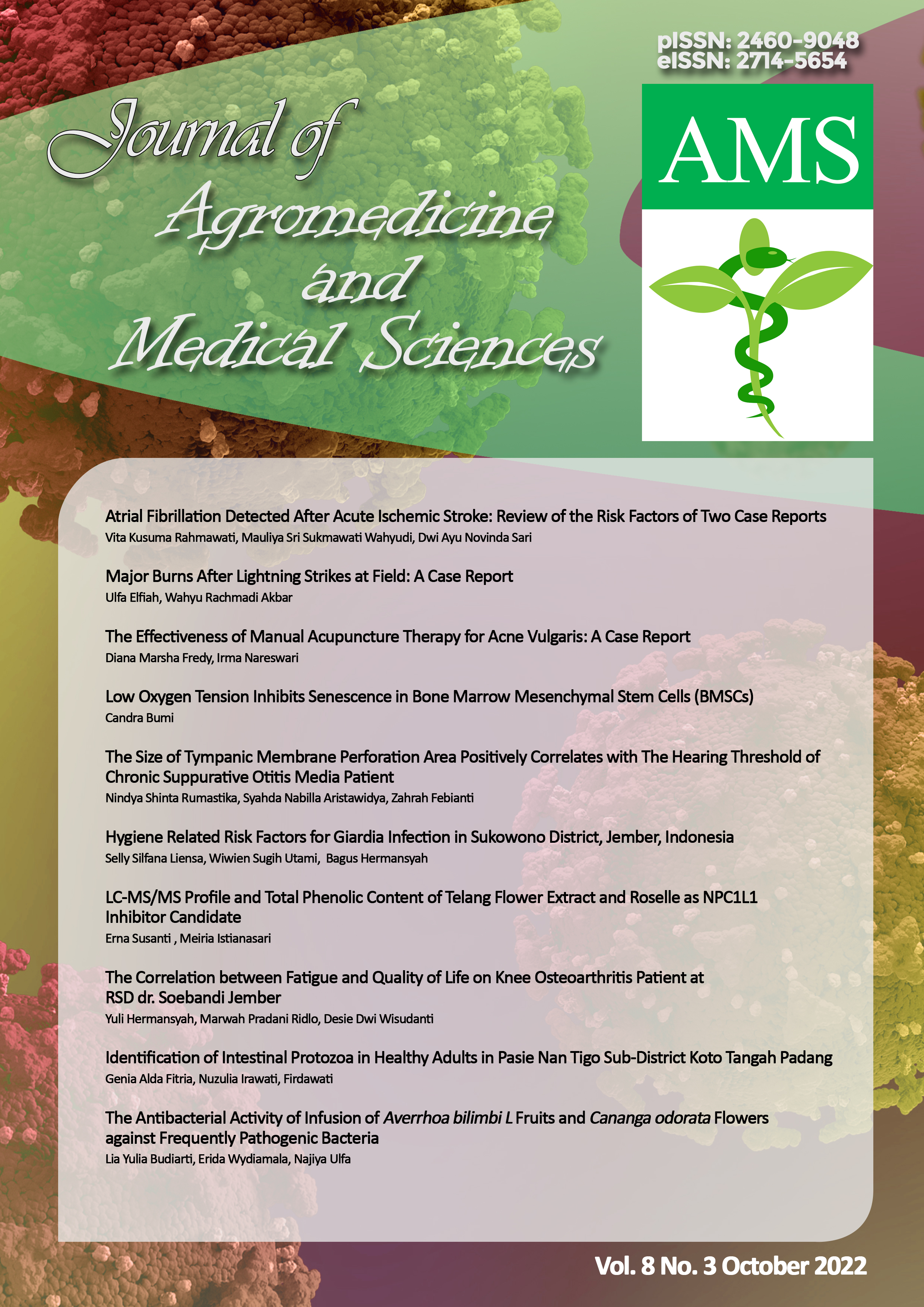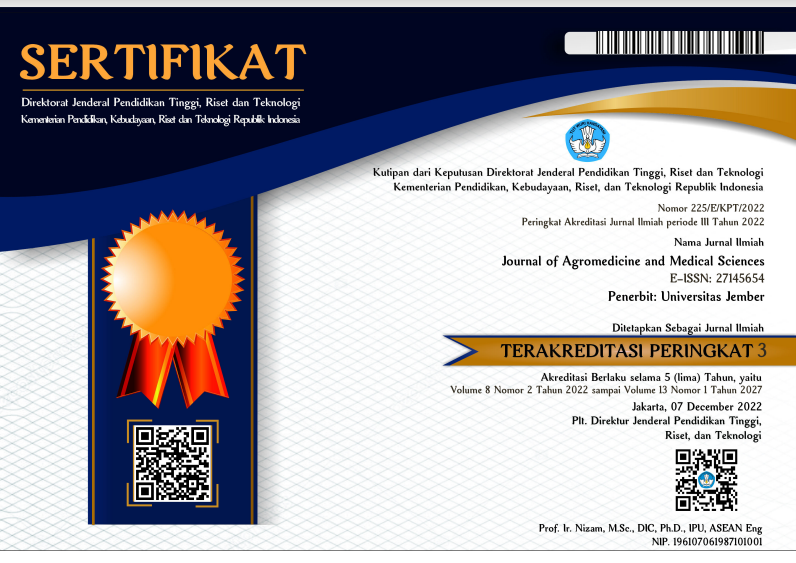The Effectiveness of Manual Acupuncture Therapy for Acne Vulgaris: A Case Report
DOI:
https://doi.org/10.19184/ams.v8i3.31014Abstract
Acne vulgaris (AV) is a chronic inflammation of pilosebaceous glands. The clinical presentation of AV can be described as an inflammatory lesion and non-inflammatory lesions. The diagnosis of AV is through clinical evaluations. AV was graded according to clinical severity using Lehmann’s criteria. AV predilection most commonly appears on the face, chest, and back. AV causes the greatest burden between 10 to 30 years old and can cause anxiety and decrease self-confidence, instigating decreased quality of life. Acupuncture is a non-pharmacological treatment modality that is performed using filiform needles at acupuncture points. An 18-year-old woman was diagnosed with a moderate degree of AV based on Lehmann's criteria. She received manual acupuncture acupoints with the needles retained for 30 minutes. The treatment was conducted 2 times a week for a total of 12 treatments. After 12 treatments of acupuncture therapy, the degree of AV was reduced from moderate to mild, with an 81.25% reduction in total lesions. Follow-up was carried out 1 month after the treatment, showing that the effect of acupuncture remained. The acupuncture mechanism works directly on acne lesions by improving microcirculation, reducing proinflammatory reactions, and increasing anti-inflammatory, as well as regulating the HPA axis which can reduce stress and improve hormones. Manual acupuncture can be considered a non-pharmacological therapeutic modality to treat AV with minimal side effects.
Downloads
References
Agachan, F., Chen, T., Pfeifer, J., Reissman, P., & Wexner, S. D. (1996). A constipation scoring system to simplify evaluation and management of constipated patients. Diseases of the Colon & Rectum, 39(6), 681–685. https://doi.org/10.1007/BF02056950
An-he, C., Xi-ping, D., & Hai-bo, Z. (2003). Clinical observation of 40 cases of acne treated by acupuncture plus herbal drugs. Journal of Acupuncture and Tuina Science, 1(4), 45–47. https://doi.org/10.1007/BF02874750
Aziz, I., Whitehead, W. E., Palsson, O. S., Törnblom, H., & Simrén, M. (2020). An approach to the diagnosis and management of Rome IV functional disorders of chronic constipation. Expert Review of Gastroenterology & Hepatology, 14(1), 39–46. https://doi.org/10.1080/17474124.2020.1708718
Bowe, W. P., & Logan, A. C. (2011). Acne vulgaris, probiotics, and the gut-brain-skin axis - back to the future? Gut Pathogens, 3(1), 1. https://doi.org/10.1186/1757-4749-3-1
Chon, T. Y., & Lee, M. C. (2013). Acupuncture. Mayo Clinic Proceedings, 88(10), 1141–1146. https://doi.org/10.1016/j.mayocp.2013.06.009
Collier, C. N., Harper, J. C., Cantrell, W. C., Wang, W., Foster, K. W., & Elewski, B. E. (2008). The prevalence of acne in adults 20 years and older. Journal of the American Academy of Dermatology, 58(1), 56–59. https://doi.org/10.1016/j.jaad.2007.06.045
Dikshit, A., Qidwai, A., Pandey, M., Shukla, S. K., Kumar, R., & Pandey, A. (2017). Risk factor assessment for acne vulgaris in human and implications for public health interventions in north central India: A survey based study. Asian Journal of Pharmaceutical and Clinical Research, 10(5), 404. https://doi.org/10.22159/ajpcr.2017.v10i5.17265
Hwang, J., & Lio, P. A. (2021). Acupuncture in Dermatology: An Update to a Systematic Review. The Journal of Alternative and Complementary Medicine, 27(1), 12–23. https://doi.org/10.1089/acm.2020.0230
Karimkhani, C., Dellavalle, R. P., Coffeng, L. E., Flohr, C., Hay, R. J., Langan, S. M., Nsoesie, E. O., Ferrari, A. J., Erskine, H. E., Silverberg, J. I., Vos, T., & Naghavi, M. (2017). Global Skin Disease Morbidity and Mortality. JAMA Dermatology, 153(5), 406. https://doi.org/10.1001/jamadermatol.2016.5538
Kou, L., Yu, N., Ren, J., Yang, B., & Tao, Y. (2020). Observation for clinical effect of acupuncture combined with conventional therapy in the treatment of acne vulgaris. Medicine, 99(18), e19764. https://doi.org/10.1097/MD.0000000000019764
Layton, A. M., Thiboutot, D., & Tan, J. (2021). Reviewing the global burden of acne: how could we improve care to reduce the burden?*. British Journal of Dermatology, 184(2), 219–225. https://doi.org/10.1111/bjd.19477
Lehmann, H. P., Robinson, K. A., Andrews, J. S., Holloway, V., & Goodman, S. N. (2002). Acne therapy: a methodologic review. Journal of the American Academy of Dermatology, 47(2), 231–240.
Ma, C., & Sivamani, R. K. (2015). Acupuncture as a Treatment Modality in Dermatology: A Systematic Review. The Journal of Alternative and Complementary Medicine, 21(9), 520–529. https://doi.org/10.1089/acm.2014.0274
Mansu, S. S. Y., Liang, H., Parker, S., Coyle, M. E., Wang, K., Zhang, A. L., Guo, X., Lu, C., & Xue, C. C. L. (2018). Acupuncture for Acne Vulgaris: A Systematic Review and Meta-Analysis. Evidence-Based Complementary and Alternative Medicine, 2018, 1–12. https://doi.org/10.1155/2018/4806734
Mohiuddin, A. (2019). A Comprehensive Review of Acne Vulgaris. Journal of Clinical Research in Dermatology, 6(2), 1–34. https://doi.org/10.15226/2378-1726/6/2/00186
Onie, K. (2005). Efek Akupunktur pada Akne Vulgaris Tipe Papulopustular.
Organization, W. H. (2008). WHO standard acupuncture point locations in the Western Pacific Region. In WHO standard acupuncture point locations in the Western Pacific region.
Son, B.-K., Yun, Y., & Choi, I.-H. (2010). Efficacy of ah shi Point Acupuncture on Acne Vulgaris. Acupuncture in Medicine, 28(3), 126–129. https://doi.org/10.1136/aim.2010.003004
Stolla, S., Shalita, A. R., Webster, G. F., Kaplan, R., Danesh, S., & Penstein, A. (2001). The effect of the menstrual cycle on acne. Journal of the American Academy of Dermatology, 45(6), 957–960. https://doi.org/10.1067/mjd.2001.117382
Tanaka, J. (2018). Pengaruh Tingkat Stres dengan Tingkat Keparahan Akne Vulgaris pada Siswa-Siswi Kelas III SMA Sutomo 2. https://repositori.usu.ac.id/handle/123456789/13559
Techasatian, L., Lebsing, S., Uppala, R., Thaowandee, W., Chaiyarit, J., Supakunpinyo, C., Panombualert, S., Mairiang, D., Saengnipanthkul, S., Wichajarn, K., Kiatchoosakun, P., & Kosalaraksa, P. (2020). The Effects of the Face Mask on the Skin Underneath: A Prospective Survey During the COVID-19 Pandemic. Journal of Primary Care & Community Health, 11, 215013272096616. https://doi.org/10.1177/2150132720966167
Thambirajah, R. (2015). Cosmetic Acupuncture: A Traditional Chinese Medicine Approach to Cosmetic and Dermatological Problems. Singing Dragon.
Wang, X., & Yin, J. (2015). Complementary and Alternative Therapies for Chronic Constipation. Evidence-Based Complementary and Alternative Medicine, 2015(d), 1–11. https://doi.org/10.1155/2015/396396
Wasitaatmadja, S. M. (2018). Akne. Universitas Indonesia Publishing.
White, A. (2009). Western Medical Acupuncture: A Definition. Acupuncture in Medicine, 27(1), 33–35. https://doi.org/10.1136/aim.2008.000372
White, A., Cummings, M., Barlas, P., Cardini, F., Filshie, J., Foster, N. E., Lundeberg, T., Stener-Victorin, E., & Witt, C. (2008). Defining an Adequate Dose of Acupuncture Using a Neurophysiological Approach – a Narrative Review of the Literature. Acupuncture in Medicine, 26(2), 111–120. https://doi.org/10.1136/aim.26.2.111
Xie, J., Liu, G., Qiao, J., Gu, Q., Gai, Y., Huang, S., Gao, A., Zhou, Y., Li, X., Wang, C., Liu, R., & Jia, J. (2009). [Multi-central randomized controlled study on electroacupuncture at Fenglong (ST 40) for regulating blood lipids]. Zhongguo Zhen Jiu = Chinese Acupuncture & Moxibustion, 29(5), 345–348. http://www.ncbi.nlm.nih.gov/pubmed/19489487
Zaenglein, A. L. (2008). Acne vulgaris and acneiform eruption. Fitzpatrick’s Dermatology in General Medicine, 690–703.
Zaenglein, A. L. (2018). Acne Vulgaris. New England Journal of Medicine, 379(14), 1343–1352. https://doi.org/10.1056/NEJMcp1702493
Zhaohui, L. (2008). Clinical Observation on the Effect of Earlobe-Bleeding plus Body Acupuncture in 85 Cases of Common Acne. Journal of Traditional Chinese Medicine, 28(1), 18–19. https://doi.org/10.1016/S0254-6272(08)60007-2
Zhu, J., Arsovska, B., & Kozovska, K. (2017). Acupuncture treatment for Acne vulgaris. Imperial Journal of Interdisciplinary Research (IJIR), 3(8), 222–223.























